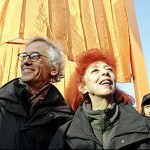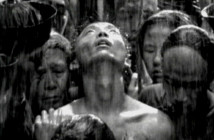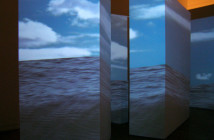As a city of world-class universities and art institutions, Boston attracts a wide variety of distinguished members of the art world to speak about their work. Over the last several years, Harvard has hosted lectures by John Baldessari, Ed Ruscha, and Thomas Struth, Mass Art had eminent photographers Tina Barney and Tim Davis give talks, and artists such as Michael Joo, Kiki Smith, and Michel Gondry spoke at MIT.
In a sense, these artist talks serve not only as a means of insight into the artwork and its production, but sometimes exhibit the personalities which engender the work with the cache of cause celebre. Who could forget Jeff Koons, cornering the market of charming disingenuousness, ending his talk at Museum School 3 years ago with this softly spoken phrase, “because at the end of the day…I’m just… Jeff.”?
These last few months have been no exception for the high quality of artists speaking in the Boston area. The Museum of Fine Arts has played host to a remarkable and eclectic group of talks recently, beginning with Jenny Holzer’s “Working in Public” lecture in early March. Part of the “Celebrity Lecture Series” at the MFA, Holzer exhibited none of the sanctimonious testimony one would associate with a “celebrity” lecturer. She, in fact, began her talk with humble slides of work made when she was still a graduate student at RISD. One such piece involved a quarter mile piece of fabric placed along a beach, collecting items that washed upon the shore. The influence of Christo’s “Wrapped Coast” reads clear in this piece, but soon after graduation, Holzer describes a need for text which becomes expressed in the form of printed adages called Truisms posted around New York City. The evolution of her text pieces into electronic signage and installation coincides with her meteoric rise in her art career. In the late 80s she is the youngest artist ever offered a solo show at the Guggenheim Museum. A phenomenal accolade by any standard, Holzer reminds, “you’re offered a solo show at the Guggenheim, what do you do?”
The challenge and complexity of integrating her artwork within specific locations is an ongoing theme in Holzer’s work. After the Lloyd Wright Guggenheim, Holzer speaks of the challenge of exhibiting in the van der Rohe designed Neue Nationalgalerie in Berlin, where the street level structure is enclosed entirely in glass and all of the art objects are relegated underground. A different set of approaches becomes necessary for Holzer when she is recently asked to work under a completely new set of circumstances, the designing of a Holocaust Garden.
In this Holzer lecture, seeing a talented artist struggle with work and evolve through ideas brings the viewer into a completely new terrain, the pleasure of seeing the artist think.
----
“I will not answer any questions about politics. I will not answer any questions about money. I will not answer any questions about generalities. I will not answer any questions about the work of other artists.” Thus began Christo’s lecture at the MFA in late April.
Despite the standoffish initial statement, Christo was affable, humorous, courteous, and responsive in his “Celebrity Lecture.” Christo presented a different set of struggles as an artist. Having fled Communist Bulgaria alone in the late 1950s, Christo has never returned to his native land, claiming residence first in Paris (where he tutored Jean-Claude in art, then married her), then in New York City, where they have lived for over 30 years. Though the situation surrounding Christo’s early life is fraught with political overtones, seldom does he overtly mention these themes in his art.
Christo showed slides of early work where he made little sculptures, eventually wrapping them in brown paper before moving on to larger items to wrap. Many of the challenges surrounding his work exist in the political and monetary realm. Out of the 38 proposed works of public art, only 19 have ever been realized. Earlier proposals, like his interest in wrapping a prominent statue of Columbus in Barcelona, were accepted decades after his initial interest. As stated by the artist, “a grown man no longer wishes to ride the tricycle he once wanted.”
Conversely, The Gates which was exhibited in New York this past February, was initially proposed in the 1970s, and went through years of city bureaucracy and design changes before repeated rejection. “Then in 2001, my friend was elected mayor,” said Christo of Mayor Bloomberg. At the cost of over $23 million, Christo and Jean-Claude paid for the entire project themselves (from the sale of early sculptures and of drawings of The Gates), rejecting all sponsorship, even refusing to sell any of the Gates after the installation was over. Though offered millions for the pieces, all of the materials from the Gates were ultimately recycled for industrial use. Christo reasoned, “I want to create a memory of a personal experience that you can never have again, and no one can ever own, like childhood.”
Through the lecture, Christo dropped a few delicious hints about his other works, that The Umbrellas had some to do with simultaneity of space in the two wealthiest economies in the world, and Wrapped Reichstag had much to do with the fall of Communism and art’s direct impact on politics. Ultimately, Christo claimed that his work was about freedom. “The freedom to move through space, the freedom from ownership, the freedom from commercialism, from hierarchy. The freedom of something that belongs to everyone and does not last.” With those statements, Christo showed a slide of his tiny New York studio, the same one he’s had for 30 years, five flights up.
----
Commencement this year for the Museum School resided in the very auditorium at the MFA where the previously mentioned lectures took place. This year’s keynote speaker was Vito Acconci, clearly apparent among a group of seated individuals on stage during the ceremony with his all black attire and casual obliviousness to the proceedings. When it came time for his speech, he shuffled constantly around the stage with his lavaliere microphone, a direct contrast with the formal graduation speeches which came before him.
Acconci spoke of his ongoing transitions in thinking about art, from moving in a private realm into the public, of creating something material to reflect the importance of touch. He struggled with the concept of the museum (while in the museum), elevating art into something that is more important “than the human, than being human.” Even the concept of the gallery as a venue for art posed great problems in his mind, that when given a gallery to show his work, he wondered if “he was simply making camouflage for what a gallery really is, which is a store.” As a result, his current work is in the realm of architecture and design, giving people something physical to relate to that they can use their hands to interact with.
The importance of music accompanying his art making process is a theme Acconci spent a good deal of time discussing. In the early 70s he began as an idealistic solidarity man listening to music by idealistic solidarity men, like Neil Young. By the late 70s and early 80s, that sentiment was replaced by the punk inflected nihilism in bands such as the Ramones and Sex Pistols. Today, Acconci sees a real evolution in society’s future, even in how human beings will function, and is drawn to the distorted electronic sound of groups like Aphex Twin.
Overall, what Acconci showed with great clarity, much like Holzer and Christo in that very auditorium, is that thinking about art ismessy. In no way did these artists gloss over the efforts and the failures in realizing their art, and in their expression of the constantly changing elements surrounding their approach to art, it was disarming to realize the struggles and instability surrounding the situation of those you admire.
----







